Table of Contents
- Introduction
- Editor’s Choice
- Global Microfluidics Market Statistics
- Microfluidics Market Share- By Application Statistics
- Regional Analysis of Microfluidics Market Statistics
- Materials Used For The Fabrication Of Microfluidic Platforms Statistics
- Droplet Microfluidics Statistics
- Applications of Microfluidics Technology Statistics
- Microfluidics in Oil and Gas Industry Statistics
- Recent Developments
- Conclusion
- FAQs
Introduction
Microfluidics Statistics: Microfluidics is the manipulation of small fluid volumes at the microscale. Offering advantages such as reduced reagent usage with enhanced control, with applications spanning biomedicine, drug delivery, chemistry, and materials science.
Microfluidic systems consist of microchannels, valves, pumps, and sensors fabricated using techniques like soft lithography.
Challenges include scaling for industrial use, standardization, and system robustness. Despite challenges, microfluidics has profoundly impacted research and industries. Revolutionizing fields like healthcare and materials science by exploiting unique microscale fluid behaviors.
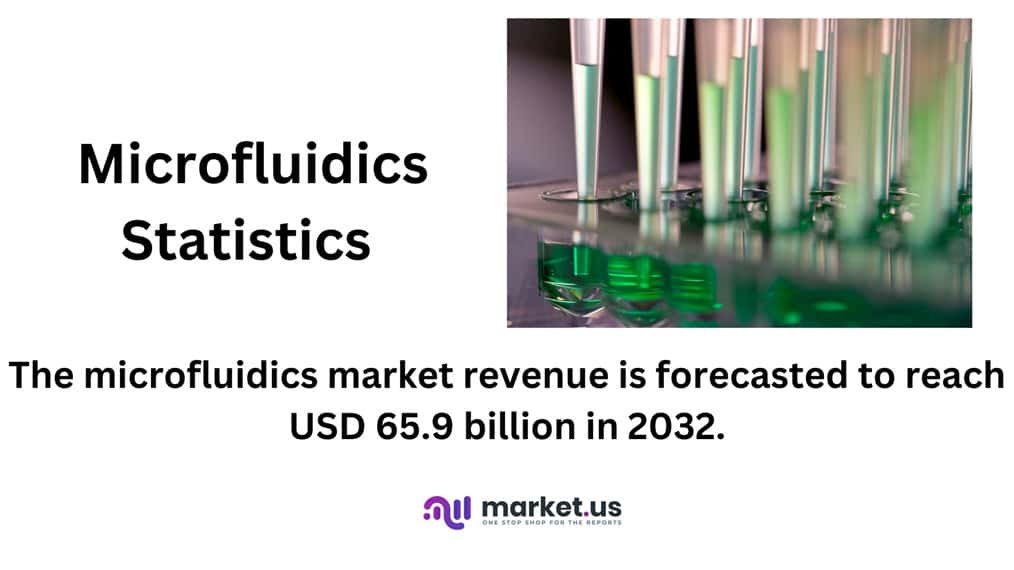
Editor’s Choice
- The microfluidics market has exhibited robust growth in recent years. With a clear upward trajectory in revenue at a compound annual growth rate (CAGR) of 15.5%.
- In 2022, the market generated approximately USD 19.3 billion in revenue.
- The microfluidics market is expected to grow significantly, with revenue forecasted to reach USD 65.9 billion in 2032.
- By 2032, the market is expected to reach USD 65.9 billion, comprising USD 49 billion in components and USD 17 billion in devices.
- Polydimethylsiloxane (PDMS) dominates with the lion’s share in microfluidics applications, commanding a substantial 49% of the market.
- In 2021, North America claimed the largest portion of revenue at 42.5%.
- Microfluidic devices encompass microchannels that span from dimensions as small as a sub-micron (measured in millionths of a meter) to a few millimeters.
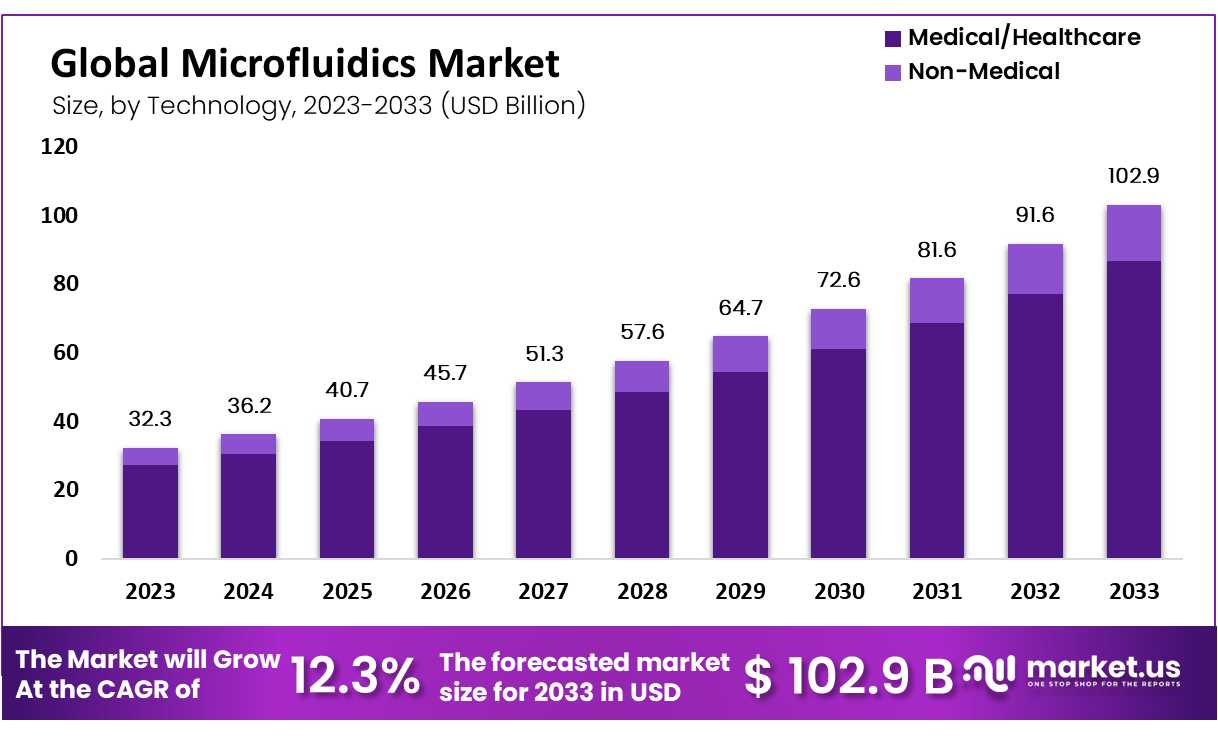
Global Microfluidics Market Statistics
Microfluidics Market Size Statistics
- The microfluidics market has exhibited robust growth in recent years. With a clear upward trajectory in revenue at a compound annual growth rate (CAGR) of 15.5%.
- In 2022, the market generated approximately USD 19.3 billion in revenue.
- Experts project that this revenue will steadily increase over the subsequent years. Reaching USD 21.9 billion in 2023, USD 24.5 billion in 2024, and USD 28.6 billion in 2025.
- The growth trend continues with expected revenues of USD 32.9 billion in 2026, USD 36.8 billion in 2027, and USD 39.8 billion in 2028.
- As we move into the late 2020s, the market is anticipated to surpass the USD 45 billion mark in 2029, and by 2030, it is projected to reach USD 50.5 billion.
- The microfluidics market is expected to grow significantly, with revenues forecasted to reach USD 57.2 billion in 2031 and USD 65.9 billion in 2032.
- This consistent growth reflects the increasing importance and wide-ranging applications of microfluidics technology across various industries.
(Source: Market.us)
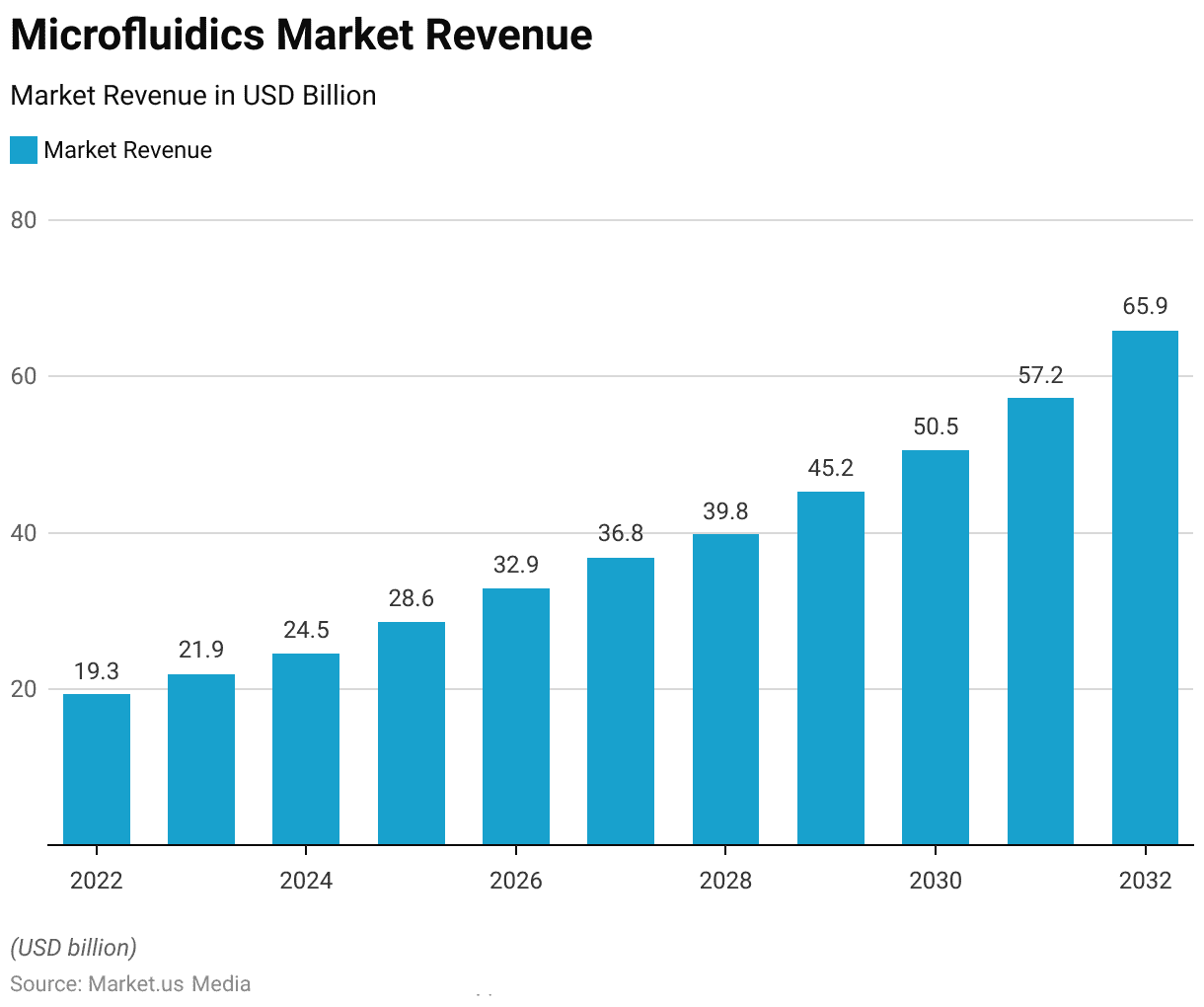
Global Microfluidics Market Revenue – By Product Statistics
- The global microfluidics market has demonstrated a robust and steadily ascending growth pattern.
- In 2022, the total market revenue amounted to USD 19.3 billion. With components contributing USD 14 billion and devices adding USD 5 billion to the overall figure.
- As we progress into the future, the market continues its expansion. With projections of USD 21.9 billion in 2023, USD 24.5 billion in 2024, and USD 28.6 billion in 2025.
- Notably, components and devices markets grow, reflecting increasing demand, with components reaching USD 21 billion and devices at USD 7 billion by 2025.
- The upward trajectory persists, with anticipated revenues of USD 32.9 billion and USD 36.8 billion in 2026 and 2027, respectively.
- Towards 2030, the microfluidics market is forecasted to surpass significant milestones, with total market revenue projected at USD 50.5 billion. Components at USD 38 billion, and devices at USD 13 billion.
- By 2032, the market is expected to reach USD 65.9 billion, comprising USD 49 billion in components and USD 17 billion in devices.
- These trends underscore the growing importance and adoption of microfluidics products globally, both in components and devices, across various industries.
(Source: Market.us)
- In the realm of microfluidics applications, different materials play a pivotal role in shaping the landscape.
- Polydimethylsiloxane (PDMS) dominates with the lion’s share, commanding a substantial 49% of the market.
- Glass follows closely behind, holding a significant 27% market share.
- Silicon, renowned for its precision and durability, accounts for 18% of the market.
- Meanwhile, other materials collectively constitute 6% of the microfluidics application market.
- This distribution underscores the significance of material choice in microfluidics, with PDMS, glass, and silicon emerging as the primary contenders in this dynamic and evolving field.
(Source: Market.us)
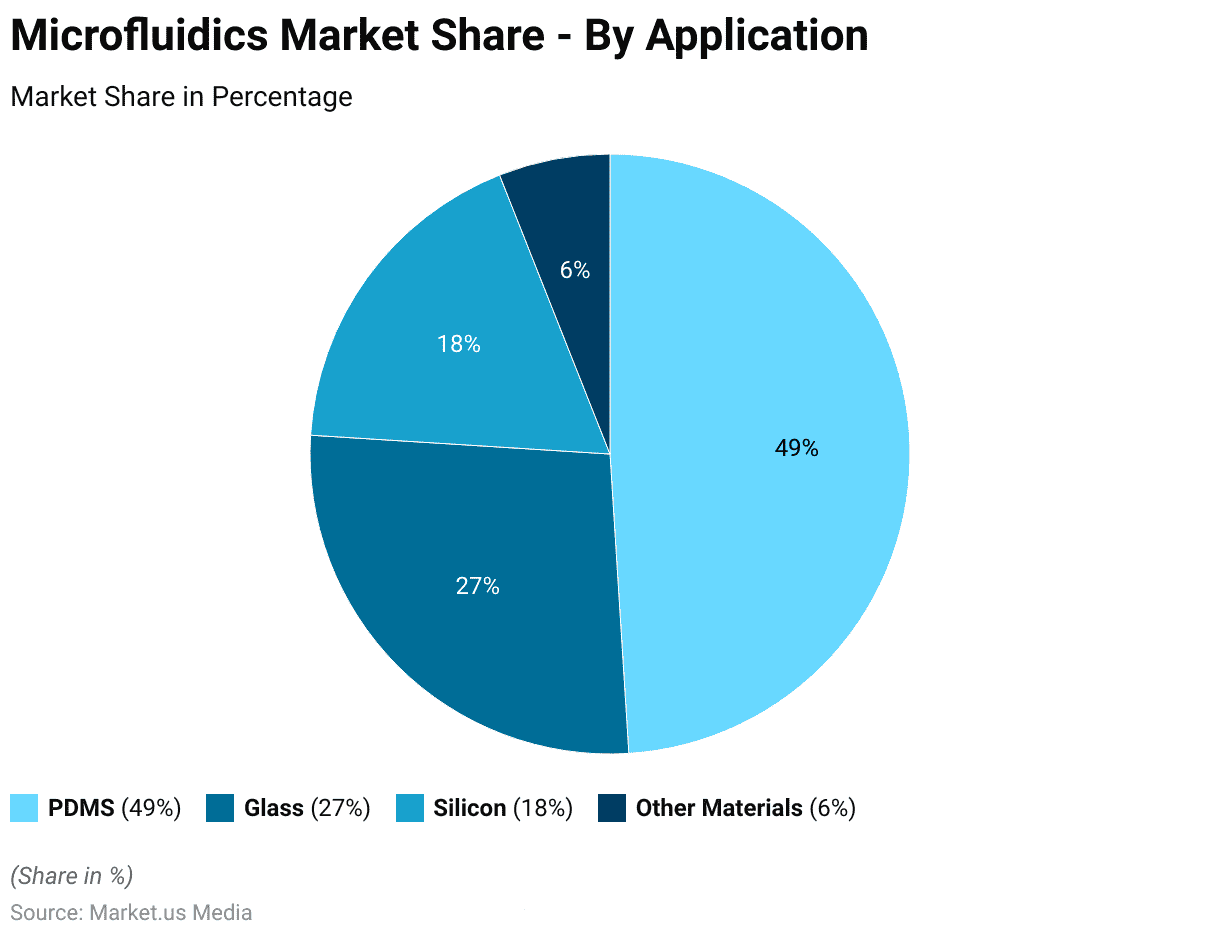
Regional Analysis of Microfluidics Market Statistics
- In 2021, North America claimed the largest portion of revenue at 42.5%.
- The presence of both emerging and established microfluidics manufacturers. Particularly in the United States, played a pivotal role in this region’s dominance from 2023-2032.
- The Asia Pacific region is poised for substantial growth, with an anticipated growth rate of 17.1% in the forecast period.
- As a developing nation with significant market potential, China presents an enticing opportunity for this industry.
(Source: Market.us)
Materials Used For The Fabrication Of Microfluidic Platforms Statistics
- When considering materials for fabricating microfluidic platforms, weighing various features to meet specific application requirements is essential.
- Metals offer low-cost advantages but have limited flexibility due to their high Young’s modulus (100–200 GPa) and low oxygen permeability.
- Silicon and glass provide excellent mechanical properties and optical clarity but are expensive and challenging to fabricate with submicron channels.
- Ceramics offer good mechanical strength but can be brittle and require specialized techniques.
- Elastomers stand out with their flexibility, low Young’s modulus (~0.0005 GPa), and ease of fabrication, but may not be suitable for all applications.
- Thermoplastics provide ease of fabrication and low absorption but lack flexibility. Resins are versatile and can be chemically modified, while hydrogels are biocompatible but can be less mechanically robust.
- Paper is low-cost and suitable for certain applications, and hybrid/composite materials offer a combination of properties.
- The choice of material should align with specific project requirements, considering factors such as biocompatibility, etc. The Ease of sterilization, and the need for rapid prototyping or tunable fluorescence.
(Source: NCBI)
Droplet Microfluidics Statistics
- Droplet microfluidic technology employs tiny liquid droplets separated by an immiscible fluid to create independent reaction vessels, typically in nanoliter to picoliter volumes, allowing for experiments in a continuous or segmented flow manner.
- Unlike the traditional method of screening drug compound libraries using 96-well plates for potential bioactivity, droplet microfluidic platforms offer significant advantages.
- They demand far less sample usage, approximately 200 times less than a 96-well plate, and considerably shorter reaction times, mainly due to a higher surface-to-volume ratio (2.5 minutes versus 2 hours).
- Furthermore, a cost-effective slip-chip approach provides a straightforward and economically viable means of conducting microfluidic reactions, eliminating the need for pumps or valves.
(Source: Science Direct)
Applications of Microfluidics Technology Statistics
Drug screening
- Drug development is a complex and lengthy endeavor involving substantial financial investments.
- Taking a new compound from its inception to market availability is a protracted process. Typically spanning a decade or more and incurring costs ranging from $1.5 billion to over $1.8 billion.
- There is an urgent need for more efficient and cost-efficient methods to assess and confirm potential drug candidates to streamline and cost-effectively manage the drug discovery process.
- Compared to traditional cell assay systems, the emerging technology of microfluidic chips is notably advantageous in high-throughput drug screening (HTDS).
- It has gained recognition for its significant contributions to advancing cell biology research.
(Source: Science Direct)
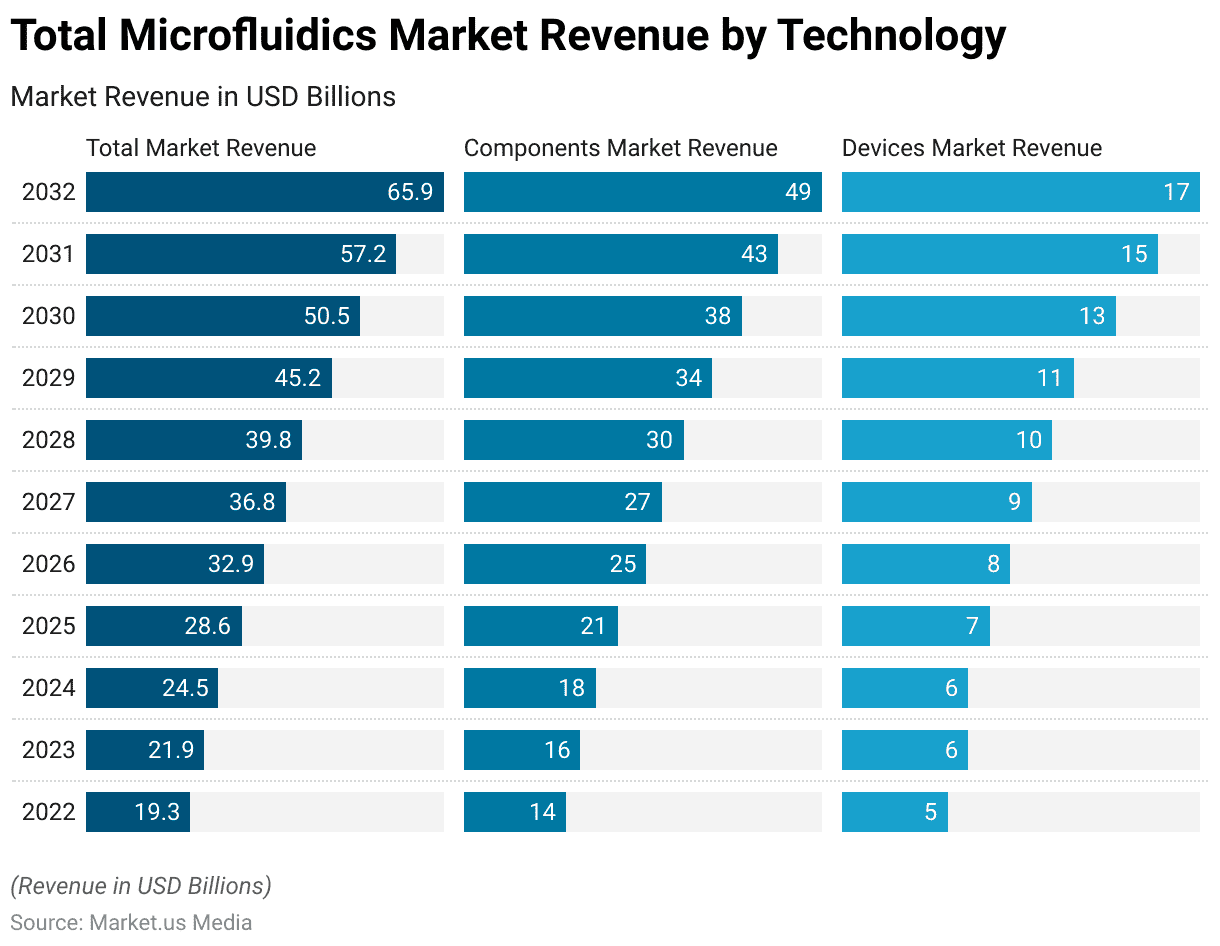
3D Cell Culture
- 3D cell culture represents an innovative approach to cell cultivation, and when combined with the distinctive structural features of microfluidic chips, it significantly enhances its advantages and applications.
- Microfluidic devices offer a highly efficient means for drug screening, facilitating high-throughput screening processes.
- In recent times, diverse microfluidic devices capable of fostering the creation of 3D cell spheroids have found application in vitro testing of anti-cancer drugs with a focus on tumor spheroids.
- These devices aim to replicate tumor tissues’ complex and heterogeneous nature to assess the cytotoxic effects of anticancer drugs.
- Additionally, a novel quantitative microfluidic platform for angiogenesis screening has been employed to monitor and quantify cellular responses to various drug concentrations.
(Source: Science Direct)
Drug Detection
- Microfluidic detection technology is gaining prominence as a highly promising analytical tool due to its advantages, including its compact size, minimal energy consumption, reduced use of reagents, and minimized waste generation.
- An innovative hybrid microfluidic device with UV detection has been crafted for the identification and quantification of three distinct psychotropic drugs.
- This inventive approach amalgamates extraction and concentration processes within a single microchip, reducing analysis duration and heightened detection sensitivity.
- Remarkably, it accomplishes the separation of these drugs at their baseline within a mere 200 seconds, achieving an impressive separation efficiency of up to 3.80×105 plates/m. This constitutes a significant advancement.
- Another noteworthy breakthrough entails the development of a nano-HPLC system based on microfluidic chips coupled with tandem mass spectrometry (nano-HPLC-chip-MS/MS), facilitating the simultaneous measurement of abused drugs and their metabolites.
- In the field of forensics, the utilization of chips incorporating biosensors is prevalent.
- These chips employ real-time drug testing and rapid detection of small molecules through biosensors that incorporate biological nanopores linked with DNA aptamers.
- These microchips exhibit the capability to swiftly identify low concentrations of cocaine (at 300 ng/mL), surpassing the drug test cutoff limit, all accomplished within a brief 60-second timeframe.
(Source: Science Direct)
Medical Diagnostics
- Microfluidic devices encompass microchannels spanning dimensions as small as sub-micron (measured in millionths of a meter) to a few millimeters (measured in thousandths of a meter).
- To put this in perspective, human hair typically has a thickness of about 100 microns (millionths of a meter).
- Microfluidics has gained increasing traction in biological sciences due to its ability to facilitate precise and controlled experiments at a reduced cost and accelerated pace.
- An example of this progress is demonstrated by Hesperos, a company based in Orlando, United States, which has successfully developed a microfluidic laboratory capable of overseeing up to five different organs simultaneously, enabling the observation of dynamic interactions among these organs.
- The channels within microfluidic devices can assume various shapes, including square or round, with dimensions ranging from a few micrometers (millionths of a meter) to 800-900 μm (billionths of a meter).
- Pumps are critical for driving fluids within these channels, supplying solutions continuously, or facilitating precise dosing.
- As reported in a 2021 article in Frontiers in Bioengineering and Biotechnology, the Revogene system employs a microfluidic cartridge. It is capable of rapidly identifying C. difficile, Strep B, and Streptococcus A through real-time PCR testing in approximately two minutes.
(Source: Frontiers in Bioengineering and Biotechnology, University of Cincinnati)
Microfluidics in Oil and Gas Industry Statistics
- In the early stages of microfluidics, limitations were evident regarding pressure and temperature capabilities.
- It’s only in recent times that many companies managed to achieve conditions relevant to reservoir studies, reaching pressures as high as 1000 bar and temperatures up to 200 ℃.
- Building upon this progress, similar interconnection systems have been developed, valued for their simplicity and durability.
- These studies encompassed measurements such as determining gas-oil ratios at 376 bar and 15 ℃ constructing full pressure-temperature phase diagrams at 67 bar and 90 ℃.
- Building on this foundation, Interface Fluidics has further advanced this research by delving into areas like measuring CO2 solubility in oil, diffusivity, extraction pressure, miscibility, and contact angle at conditions of 130 bar and 50 ℃.
- Additionally, they’ve explored CO2 dew point measurements at 144 bar and 50 ℃ and MMP (Minimum Miscibility Pressure) measurements at pressures of up to 350 bar and temperatures as high as 144 ℃.
(Source: Interface Fluidics)
Recent Developments
Acquisitions and Mergers:
- Biotech XYZ acquires – In February 2024, XYZ Biotech, a leading player in biomedical instrumentation. Acquired Microfluidics, a pioneer in chip-based analysis systems, for approximately $350 million. This acquisition aims to enhance XYZ’s capabilities in the fast-growing lab-on-a-chip market.
- Global Tech Corp merges with MicroFlow Analytics – Announced in March 2024, this merger is valued at around $500 million. It is expected to create a powerhouse in the microfluidics landscape, combining expertise in microfluidic design with advanced analytics.
New Product Launches:
- Launch of ‘FlowMini’ by MicroQuick Devices – In January 2024, MicroQuick Devices introduced ‘FlowMini’, a portable microfluidic analyzer designed for point-of-care testing in rural and remote areas. The product has seen rapid adoption due to its affordability and ease of use.
- NanoDrip’s new ‘LabChip X’ Series – Released in April 2024, NanoDrip unveiled a series of high-throughput microfluidic chips that reduce the time for complex biochemical analyses from hours to minutes, targeting major pharmaceutical and research labs.
Funding:
- FluidicAnalyse Series B Funding – FluidicAnalyse, a startup specializing in microfluidic diagnostics, secured $120 million in Series B funding in May 2024. The funding round was led by VentureHealth Partners, aiming to expand the company’s reach in clinical diagnostics.
- Seed Capital to DropTech – In March 2024, DropTech, a new entrant in microfluidic technology focusing on environmental testing, raised $10 million in seed funding from GreenTech Innovations, highlighting the growing interest in applying microfluidic technologies for environmental and sustainability efforts.
Research Grants and Government Funding:
- $50 million NIH grant awarded to BioMicroFluids Inc. – In December 2023, BioMicroFluids Inc. received significant funding from the National Institutes of Health (NIH) to develop microfluidic systems for cancer research, underlining the government’s investment in innovative health technologies.
- EU’s Horizon 2020 program allocates €30 million to microfluidic projects – A consortium of European universities and tech companies received substantial funding to advance research in microfluidics applied to renewable energy solutions, marking a pivotal step towards integrating microfluidic tech in green energy applications.
Regulatory Approvals:
- FDA approval for QuickDiagnose Microfluidics Kit – In February 2024, QuickDiagnose’s latest microfluidic test kit for rapid detection of infectious diseases received FDA approval, paving the way for its entry into the U.S. healthcare market.
Partnerships:
- TechFlow Solutions partners with Major Pharma – Announced in April 2024, this partnership aims to co-develop a microfluidic-based drug delivery system. Indicating a trend towards collaboration between tech and pharmaceutical industries to leverage innovative drug administration solutions.
Conclusion
Microfluidics Statistics – Microfluidics has emerged as a game-changing technology with diverse applications, from healthcare to environmental monitoring and materials science.
Its precision in handling small fluid volumes has led to rapid advancements. Enabling point-of-care diagnostics, single-cell analysis, and genomics and drug development innovations.
Commercially, microfluidics is on the rise, but challenges such as scalability and standardization need addressing. Nonetheless, its impact on research, industry, and technology is undeniable, with continued growth anticipated in the coming years.
FAQs
Microfluidics is a multidisciplinary field that involves manipulating and controlling tiny volumes of fluids. Typically in the microliter or nanoliter range, within microchannels and structures on a microscale.
Microfluidics has many applications, including biomedical research, drug development, diagnostics, genomics, chemical synthesis, environmental monitoring, and more.
The microfluidic devices are fabricated using soft lithography, micro-machining, and 3D printing techniques. The most commonly used materials are PDMS, glass, and silicon.
Microfluidics offers advantages like reduced sample and reagent usage, faster reactions, precise control, and the ability to perform complex experiments in small, compact devices.
Microfluidics is crucial in developing rapid and portable diagnostic tests for diseases, including COVID-19. It enables the miniaturization of lab-on-a-chip devices for point-of-care testing.
Discuss your needs with our analyst
Please share your requirements with more details so our analyst can check if they can solve your problem(s)



